Silver Nanomaterials for Biological Applications
Steven J. Oldenburg*, Aaron E. Saunders
nanoComposix, Inc., San Diego, California 92111 *
Silver nanomaterials have unique physical, chemical, and optical properties that are currently being leveraged for a wide variety of biological applications. A resurgence of interest in the utility of silver as a broad-based antimicrobial agent has led to the development of hundreds of products that incorporate silver nanoparticles to prevent bacterial growth on surfaces. Additionally, silver nanoparticles have an optical color that is a function of their size and shape. The strong coupling of silver nanoparticles to specific wavelengths of incident light can be utilized to develop ultrabright reporter molecules, highly efficient thermal absorbers, and nanoscale “antennas” that can amplify the strength of the local electromagnetic field. Here we summarize how precise engineering of silver nanoparticle size and shape enables a wide range of biological applications.
Silver Nanomaterial Surface Chemistry, Morphology, and Optical Properties
The reaction conditions during silver nanomaterial synthesis can be tuned to produce colloidal silver nanoparticles with a variety of morphologies, including monodisperse nanospheres, triangular prisms, nanoplates, cubes, wires, and nanorods. For use in biological applications, the silver nanoparticle’s surface chemistry, morphology, and optical properties must be carefully controlled to obtain the desired functionality in the target environment.
Surface Chemistry
In many biological applications, it is desirable to tune colloidal stability in different buffers or media, or to vary particle binding or uptake via surface interactions. The surface chemistry of the particles (i.e., the binding strength, functional groups, and size of the capping agents) can be varied to provide an additional level of control over particle behavior. In aqueous media, many nanoparticles are electrostatically stabilized through the addition of charged species at the particle surface. The type and density of charges can be determined by measurement of the zeta potential of the colloid. Typically, the zeta potential of silver nanoparticles is negative due to surface-bound molecules such as citrate. By exposing the nanoparticle to more tightly coordinating ligands (often containing thiol or amine functionality), new capping agents can bind to the surface and alter the chemical functionality and zeta potential of the nanoparticle. Replacing the citrate ions with short chain methoxy-terminated polyethylene glycol (mPEG) molecules provides a zeta potential near neutral, while coating the particles with branched polyethylenimine (BPEI) creates an amine-dense surface with a highly positive zeta potential.
Morphology and Optical Properties
Silver and other noble metal nanoparticles exhibit strong interaction with light, because the electrons on the metal surface undergo a collective oscillation when they are excited by light at specific wavelengths. This oscillation is known as surface plasmon resonance (SPR), and it causes the absorption and scattering intensities of silver nanoparticles to be much higher than identically sized non-plasmonic nanoparticles. The absorption and scattering properties of silver nanoparticles can be tuned by controlling the particle size, shape, and the local refractive index near the particle surface.
The optical properties of spherical silver nanoparticles are highly dependent on the nanoparticle diameter and uniformity, which can be controlled by carefully adjusting fabrication conditions to produce size-controlled particles with coefficients of variation (standard deviation of the diameter/mean diameter) less than 15% (Figure 1A). The extinction spectra of 10 sizes of silver nanoparticles at identical mass concentrations (0.02 mg/mL) are displayed in Figure 1B. Smaller nanospheres primarily absorb light with peaks near 400 nm, while larger spheres exhibit increased scattering, broader spectral peaks and peak intensities at longer wavelengths.
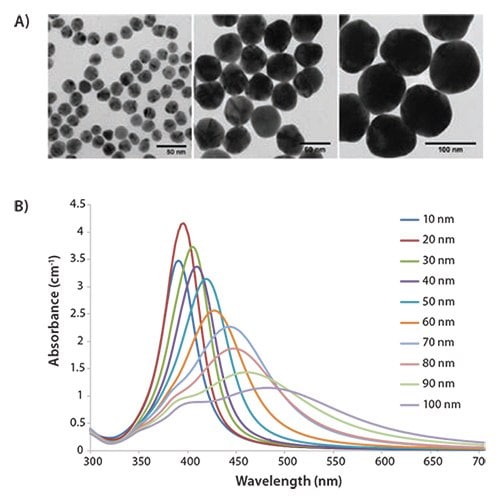
Figure 1.A) Transmission electron micrographs (TEM) of uniform 20 nm, 60 nm, and 100 nm diameter silver nanoparticles. B) Extinction (the sum of scattering and absorption) spectra of silver nanoparticles with diameters ranging from 10–100 nm at mass concentrations of 0.02 mg/mL.
Silver nanoplates are surface plasmon resonant (SPR) platelet-shaped nanoparticles (Figure 2A) that have extremely large absorbing and scattering cross-sections across the visible and near-IR regions of the spectrum. By precisely controlling the plate diameter and thickness, the nanoplate’s optical resonance can be tuned to peak at specific wavelengths (550 nm–950 nm, Figures 2B and 2C). Nanoplates have applications in Surface-Enhanced Raman Scattering (SERS), photovoltaics, molecular detection, and photothermal-based therapies.
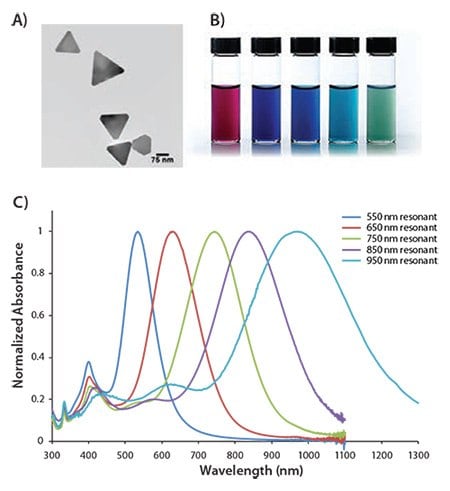
Figure 2.A) Transmission electron microscope (TEM) image of silver nanoplates. B) Dispersions of nanoplates exhibit colors that reflect the ability to tune the plasmon resonance of the nanoplates across the visible and near-infrared portion of the spectrum (C).
Surface-enhanced Spectroscopies
Other applications for silver nanoparticles in biological applications are based on utilizing the enhanced electromagnetic field on the surface and near the surface of the silver nanoparticle. At the plasmon resonant wavelength, the silver nanoparticles act as nanoscale antennas, increasing the intensity of the local electromagnetic field.
One spectroscopic technique that benefits from enhanced electromagnetic fields is Raman spectroscopy, where molecules can be identified by their unique vibrational modes. While intrinsic Raman scattering of photons from molecules is weak and requires long measurement times to obtain a Raman spectrum, Surface Enhanced Raman Scattering (SERS) from molecules near the surface of plasmonic metal nanoparticles offers greatly enhanced Raman signals. The SERS effect can enhance the Raman scattering of bound molecules by as much as 14 orders of magnitude, allowing for the detection of even single molecules.1,2 The enhancement is driven by the high electric field intensities (or “hot spots”) created at locations on the nanoparticle surface and is, therefore, highly dependent on the nanoparticle geometry, surface features, and the specific position of the molecule. Metal nanoparticles exhibiting SERS from associated molecules (SERS nanotags) have been used as labels in a range of biomedical applications and platforms including immunoassays, nucleic acid sequence detection, in vitro cellular imaging, in vivo imaging, and flow cytometry.
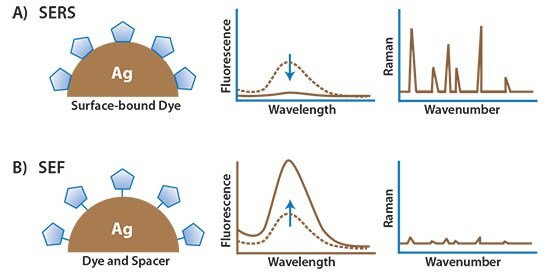
Figure 3.A) An organic fluorophore attached directly to a metal substrate typically has quenched fluorescence but a strong surface enhanced Raman spectrum (SERS). B) Spacing the fluorophore off of the metal surface results in surface enhanced fluorescence (SEF).
The increased localized field extends beyond the surface of the nanoparticle and, by placing a fluorophore a short distance away from the surface of a silver nanoparticle, gives rise to a phenomenon known as surface enhanced fluorescence (SEF). SEF was first observed in the 1970s and can enhance the fluorophore emission intensity by orders of magnitude.3 The enhancement of the fluorophore can be attributed to two effects: 1) the focusing of the incoming light due to the large absorption and scattering cross-sections of the plasmonic particle, and 2) a decrease in the fluorescence lifetime of the fluorophore that allows the excited state to return to the ground state at a higher frequency. Collectively, these two phenomena mitigate two drawbacks common to organic dye molecules: 1) the low absorbance cross section of molecules, and 2) a slow cycle time for excitation and emission per molecule. In order to maximize the fluorescence enhancement of a fluorophore, the optical properties of the metal nanoparticle and the geometry of the SEF nanotag must be carefully engineered by precisely controlling the metal particle size, shape, and composition as well as the distribution of the fluorophore near the particle surface.
A schematic of the different attachment strategies necessary to achieve optimal SERS and SEF effects with a dye molecule is shown in Figure 3. Attaching a dye molecule to a metal nanoparticle typically results in quenching the emission due to energy transfer between the excited state of the fluorophore and the electronic states of the metal. In this case, the Raman spectrum of the molecule is strongly enhanced due to the high electromagnetic field at the surface of the particle (Figure 3A). Spacing the fluorophore slightly away from the particle surface prevents fluorescence quenching and due to the high local electromagnetic field, results in a large increase in the photoemission from the molecule (Figure 3B).
Antimicrobial Applications
The antimicrobial effects of silver can be traced back to the Greeks and Romans, who extended the potability of water by storing it in silver vessels. Silver ions are released from the container walls and provide an antimicrobial effect via a silver ion interaction with thiol groups of vital bacterial enzymes and proteins. This affects cellular respiration and transport of ions across membranes, resulting in cell death.4,5 Additional antimicrobial pathways specific to silver nanoparticle toxicity have also been proposed. Silver nanoparticles can anchor and subsequently penetrate the bacterial cell wall, leading to damaging structural changes in the cell membrane.6 Generation of reactive oxygen species at the surface of the silver nanoparticles can result in oxidative stress providing a further mechanism for cell damage.7 The specific toxicity to bacteria, while maintaining low toxicity for humans, has led to the integration of silver nanoparticles in a wide variety of products including wound dressings, packaging materials, and antifouling surface coatings.
A central mechanism of silver nanoparticle antimicrobial activity is to provide a high surface area source for silver ions. In an aqueous environment, the particles oxidize in the presence of oxygen and protons according to the stoichiometric reaction

releasing Ag+ ions as the particle surface dissolves. As the concentration of silver ions in solution increases, an equilibrium state is approached and silver dissolution slows. However, if there are molecules that have an affinity for silver in the local environment, such as thiols or chlorine, the concentration of free silver ions in solution remains low, and silver ion dissolution from the silver nanoparticles continues. Silver nanoparticle’s long-term antimicrobial effectiveness relies on the maintenance of an efficacious concentration of silver ions in a wide variety of different solutions.
Silver Ion Release Rates
Silver ion release rates from silver nanoparticles depend on a number of factors including nanoparticle size, shape, capping agent, aggregation state, and the environment. The smallest particle sizes typically have the fastest ion release rates due to the high surface energy of highly curved or strained nanoparticle surfaces. Shape also contributes to the ion release rate. Figure 4 shows the ion release profiles of different-sized spherical nanoparticles and silver nanoplates.
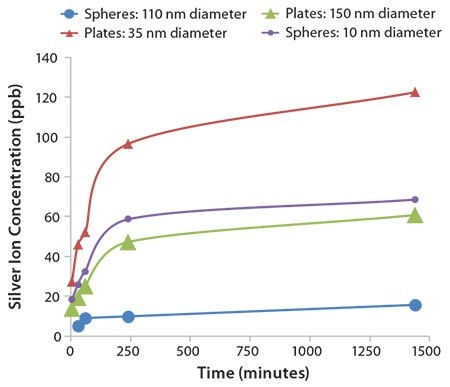
Figure 4.Silver ion release as a function of time, for silver spheres and nanoplates of different sizes. The same mass of silver is used in each sample.
As expected, smaller (10 nm diameter) silver nanospheres exhibit a significantly higher release rate and final ion concentration than larger (110 nm diameter) nanospheres. Anisotropic silver nanoplates have significantly different ion release rates than spherical particles. Large silver nanoplates, with an average diameter of 150 nm, have nearly the same silver concentration profile over time as the 10 nm spherical silver particles, and the 35 nm diameter plates exhibit silver ion concentrations nearly twice as high as the smaller silver spheres.
The functionalization of the surface also plays a role in the ion release rate with tightly bound thiol-containing capping agents generally reducing release rates compared to more easily displaceable stabilizing molecules such as citrate. Aggregation of the particles will also decrease ion release rates but the larger impact of aggregation is the change of kinetics and distribution due to settling. The factor that affects ion release rate the most is the nanoparticle environment. Elevated temperatures, the presence of chlorine, thiols, and oxygen all affect the release rate. In some physiological media, complete dissolution of silver nanoparticles can occur in just a few hours.
By understanding how the physical and chemical properties of silver nanoparticles impact release rates, silver nanomaterial composites can be designed so that a desired ion release profile can be obtained. This optimization is important so that the amount of required silver can be minimized, leading to a more cost-effective product that has minimal long-term environmental impact.
Tagging and Targeting for Bio-imaging
Silver nanoparticles absorb and scatter light with extraordinary efficiency and are utilized in tagging and imaging applications. The high scattering cross-section of the nanoparticles allow for individual silver nanoparticles to be imaged under dark field microscopy (Figure 5) or hyperspectral imaging systems.8 By coupling biomolecules such as antibodies or peptides to the surface of the silver nanoparticles, the silver nanoparticles can be targeted to specific cells or cellular components. Attachment of targeting molecules to the surface can be done via absorption onto the nanoparticle surface or through either covalent coupling or physisorption. Physisorption is typically performed using silver nanoparticles with an easily displaceable capping agent such as citrate. By adjusting the pH and salt concentration, silver nanoparticle antibody conjugates with high affinity and low non-specific background can be obtained. Improved performance can be achieved by covalently binding the antibody to the surface. One covalent approach is to functionalize the silver nanoparticles with mixed monolayers of thiolated PEG molecules, where a portion of the thiolated PEG contains carboxylic acid functionality and the remainder of the molecules are inert (methoxy-terminated). Using an ethyl(dimethylaminopropyl) carbodiimide (EDC) coupling, the carboxylic acid can then be covalently linked to free amines on the antibody, yielding a targetable silver nanoparticle probe.
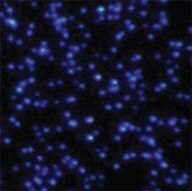
Figure 5.Dark field microscopy image of 60 nm diameter silver nanospheres.
Nanomedicine and Nanosafety
The use of silver nanoparticles in in vitro and in vivo applications is rapidly increasing. In addition to silver nanoparticle-based ultrabright fluorescent labeling and Surface Enhanced Raman Spectroscopy (SERS) nanotags, other applications for silver nanoparticles include their use as thermal sources for hyperthermia and thermally modulated drug release from particle surface coatings. Silver nanoparticles can also be incorporated into core/shell constructs. An amorphous silica shell grown uniformly onto silver nanoparticle cores can have a variety of functional groups conjugated into the shell, providing a means for electrostatic or other interactions between the shell and a molecule. Fluorophores, drug molecules, or other high molecular weight organic molecules can be integrated within the shell for in vitro or in vivo labeling or drug delivery applications.
Many of the future biomedical applications of silver nanoparticles will require that the interaction of the nanoparticle with biological systems is well understood. For in vivo applications, a major challenge is designing particles that have long circulation times and low toxicity. Experiments to optimize nanoparticle performance in in vivo systems are complicated by the complexity of both the nanoparticles themselves and their environment. The biological fate and transport of the nanoparticle is dependent not only on the primary characteristics of the particles (e.g., core chemistry, size, shape, crystallinity, surface, and aggregation state), but also on secondary characteristics that rely on the nanoparticle interaction with the target biological systems (e.g., protein corona, dissolution rate, biodistribution).9 Experiments performed with sets of precisely manufactured and well-characterized nanomaterials with only a single modified property (e.g., core chemistry, size, shape, or surface) provide insight into the biological response of the varied property and assist in determining the optimal characteristics for effective performance.
Conclusions and Future Outlook
The unique optical properties and broad-based antimicrobial properties of silver nanoparticles have led to a rapid rise in the incorporation of silver nanoparticles in biological applications. The high level of control that is available for controlling size, shape, and surface of silver nanoparticles provides a powerful library for not only generating functional materials for biological applications but also for understanding the fundamental mechanisms of transport and interaction of nanoparticles in biological systems. This understanding, coupled with the construction of more complex multifunctional silver nanocomposites, will enable the next generation of silver nanoparticle-based probes, devices, and therapeutics.
Materials
To continue reading please sign in or create an account.
Don't Have An Account?